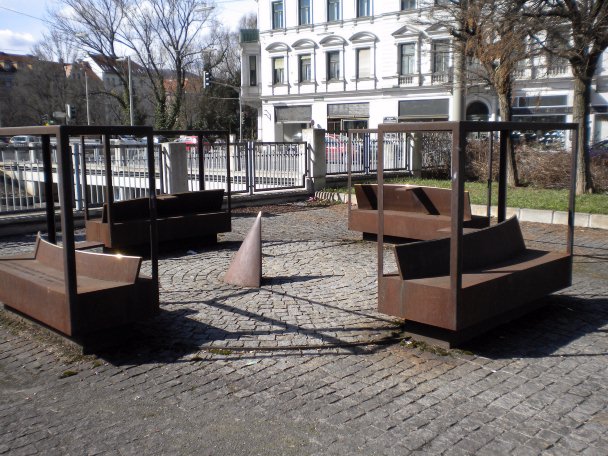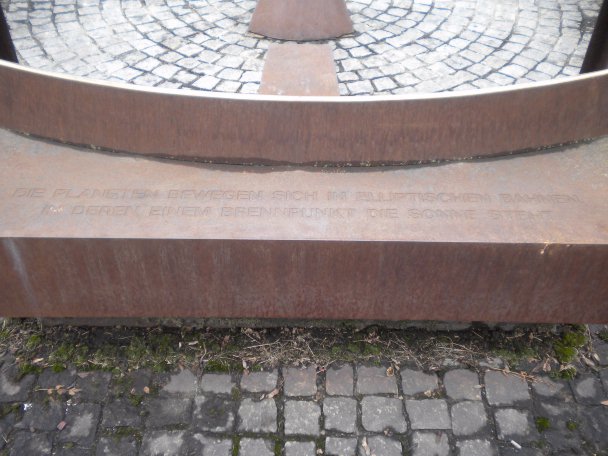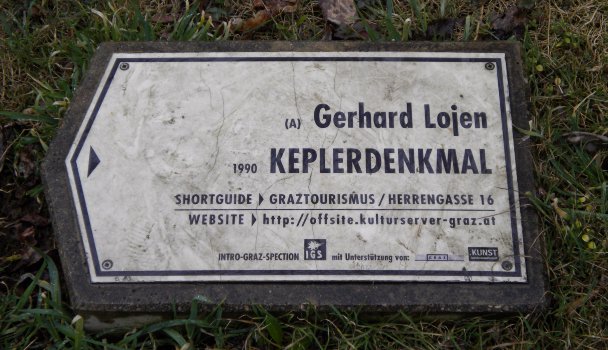

![]() Das Denkmal neben dem Umspannwerk an der
Keplerbrücke wurde im Jahr 1990 mit diesem zusammen
errichtet. Damit sich die Bedeutung des Denkmal erschließt bedarf es einer genaueren
Betrachtung. Auf dem Boden (vergleiche das Bild ganz unten auf dieser
Seite) findet man den Hinweis, dass es
Johannes
Kepler gewidmet ist.
Es besteht aus vier ähnlich gestalteten Quadern, die in den oberen Teilen hohl sind.
Die unteren Partien erscheinen wie Sitzbänke, wobei die vier "Lehnen" vier Segmente
einer Ellipse bilden. Im dem einen Brennpunkt der Ellipse findet man einen Kegelausschnitt,
der andere Brennpunkt ist durch eine kleine Metallscheibe auf dem Bodenbelag markiert.
Das Denkmal neben dem Umspannwerk an der
Keplerbrücke wurde im Jahr 1990 mit diesem zusammen
errichtet. Damit sich die Bedeutung des Denkmal erschließt bedarf es einer genaueren
Betrachtung. Auf dem Boden (vergleiche das Bild ganz unten auf dieser
Seite) findet man den Hinweis, dass es
Johannes
Kepler gewidmet ist.
Es besteht aus vier ähnlich gestalteten Quadern, die in den oberen Teilen hohl sind.
Die unteren Partien erscheinen wie Sitzbänke, wobei die vier "Lehnen" vier Segmente
einer Ellipse bilden. Im dem einen Brennpunkt der Ellipse findet man einen Kegelausschnitt,
der andere Brennpunkt ist durch eine kleine Metallscheibe auf dem Bodenbelag markiert.
An den Ellipsensegmenten sind kleine viereckige Metallscheiben herausgebildet, die auf den Viertelkegel in der Mitte weisen und so aufgrund ihrer variierenden Breite das zweite Keplersche Gesetz symbolisieren. Dieses, wie auch die beiden anderen Gesetze findet man zusammen mit J. Keplers Namen, Lebensdaten und der Bezug zur Stadt Graz auf den horizontalen Flächen der vier quaderförmigen Gebilde (siehe auch weiter unten):
| Die Planeten bewegen sich in elliptischen Bahnen in deren einem Brennpunkt die Sonne steht. Die Strecke Planet-Sonne (Radiusvektor) bestreicht in gleichen Zeiten gleiche Flächen. Die Quadrate der Umlaufzeiten zweier Planeten verhalten sich wie die Kuben ihrer großen Bahnachsen. Johannes Kepler ( 1571 - 1630 ) wirkte in Graz von 1594 bis 1600. |
Die Fotos wurden im März 2011 aufgenommen.

![]() The monument shown above beside the transformer station near the
Kepler bridge was erected in 1990. For approaching its
meaning it needs a a closer look for the details. On the ground (confer the
picture at the end of this page) there is a plaque mentioning that this
monument refers to
Johannes
Kepler. Four cuboids constitutes the monument whose upper parts are hollows. Their
lower parts look like banks, but the upper edges of the back-rests form four segments of an
ellipse. One of the focal points is marked by a cone, the other focus is marked with a
simple metal plate on the ground.
The monument shown above beside the transformer station near the
Kepler bridge was erected in 1990. For approaching its
meaning it needs a a closer look for the details. On the ground (confer the
picture at the end of this page) there is a plaque mentioning that this
monument refers to
Johannes
Kepler. Four cuboids constitutes the monument whose upper parts are hollows. Their
lower parts look like banks, but the upper edges of the back-rests form four segments of an
ellipse. One of the focal points is marked by a cone, the other focus is marked with a
simple metal plate on the ground.
Each of the segments of the ellipse are equipped with quadrangular metal plate pointing to the cone. Due to their different sizes they symbolize the second Kepler's law of planetary motion. This as well as the other two laws and Kepler's name, dates of life and a hint on his relation to the city of Graz are engraved in the horizontal faces of the cuboidal frames (certainly in German, see the picture above the English text). They reads like:
| The planets move on elliptic orbits, the sun is located at one of
its focal points. The line segment planet-sun (radius vector) covers areas of equal size for equal time intervals. The squares of the orbital periods of two planets are proportional to the cubes of the major axes of their orbits. Johannes Kepler ( 1571 - 1630 ) worked in Graz from 1594 up to 1600. |
The photographs were taken in March 2011.

| Back to the main page | Created by Wolfgang Volk in March 2011 |